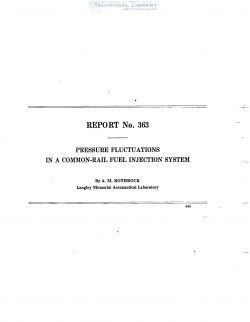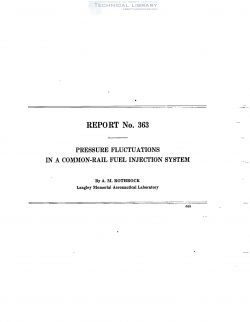naca-report-363

- Version
- 146 Downloads
- 1.19 MB File Size
- 1 File Count
- August 25, 2016 Create Date
- August 25, 2016 Last Updated
National Advisory Committee for Aeronautics, Report - Pressure Fluctuation in a Common Rail Fuel Injection System

The tests reported herein were conducted at the Langley
ilfemorial Aeronautical Laboratory, Langley Field, Va.,
to determine experimentally the instantaneous pressures
at the discharge orifice of a common-rail fuel injection
system in which the timing raise and cut-of value were
at some distance from the automatic fuel injection ualre,
and also to determine the methods by which the pressure
fluctuations could be controlled.
The instantaneous pressures at the discharge orifice
of a common—rail fuel injection system were determined
by analyzing the stem-lift records of an automatic injec-
tion ralre. The fuel injection was obtained by releasing
fuel from a reservoir under high pressure by means of a
cam-operated timing ralre. The period of injection was
controlled by the opening of a cam-operated by-pass valve
which reduced the fuel pressure between the timing valve
and the injection salve.
In order to control the injection of fuel into the
combustion chamber of a compression-ignition engine,
it is necessary to know the pressure variations at the
discharge orifice as well as the time interval of injec-
tion. These pressure variations are controlled by the
design of the fuel injection system and the physical
properties of the fuel. The system should be designed
to meet the requirements imposed by these physical
properties in such a manner that. the instantaneous
pressures at the discharge orifice cause injection of the
fuel according to the requirements of efficient combus-
tion. Since fuel oils are compressible, they are subject
to pressure wave phenomena. Because of the fluctua-
tions of these pressures in the injection system, the
instantaneous pressures can not be recorded with a
static gauge.
The quantity of fuel delivered by a common-rail
fuel injection system is controlled either by the lift
of a mechanically operated fuel injection valve or by
the time interval during which the oil in the high-pres-
sure reservoir is released to the injection valve. The
first. type has not. been used extensively with high-speed
engines, because of the difficulty of controlling the rate
of fuel flow by controlling the lift of a mechanically
operated valve. With the second type it is necessary
to have one or two mechanically operated valves in
conjunction with either an automatic injection valve
or an open nozzle.
| File | Action |
|---|---|
| naca-report-363 Pressure Fluctuation in a Common Rail Fuel Injection System.pdf | Download |

Comment On This Post